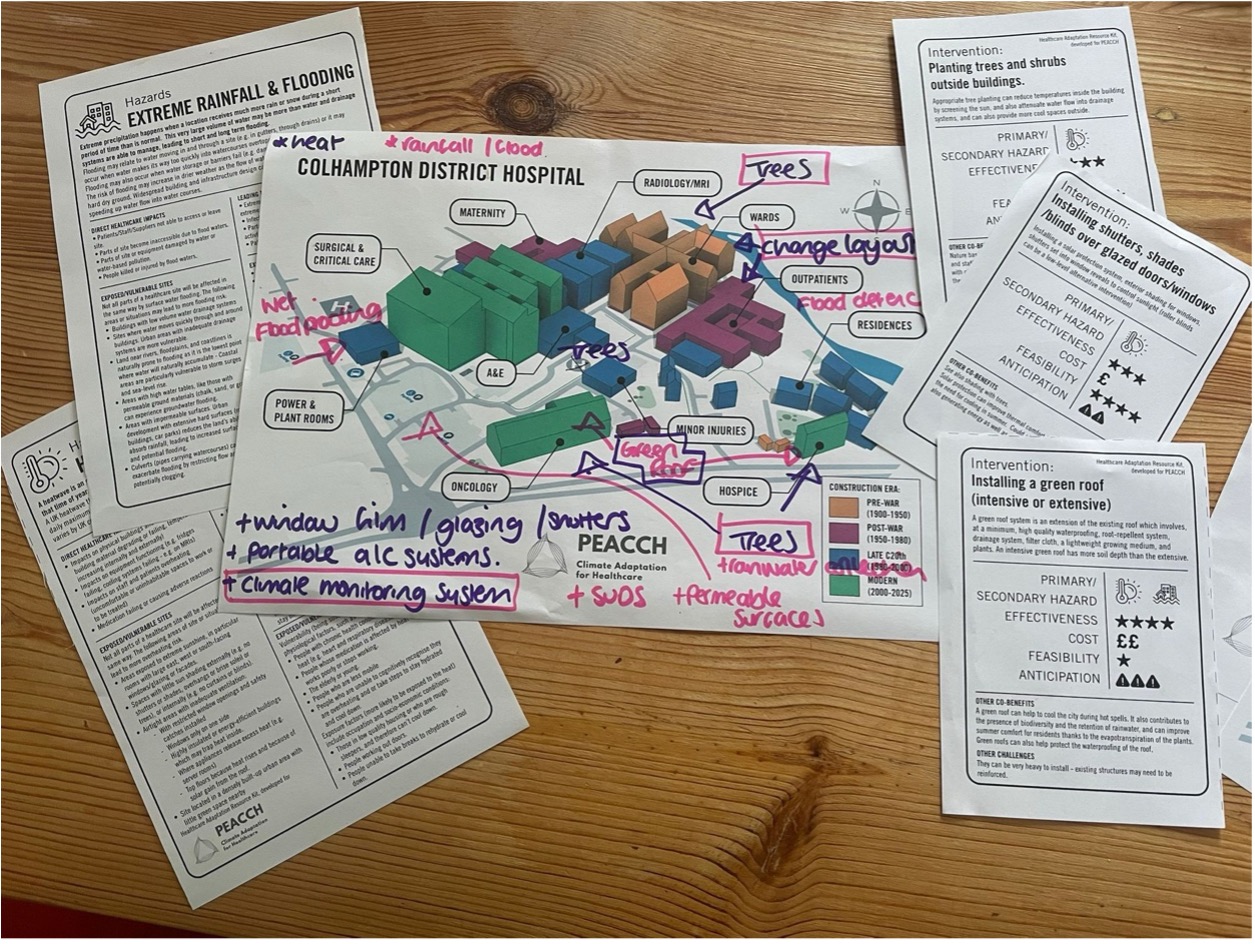HARK is a key output of the PEACCH project. We wanted to develop a new suite of resources to support NHS practitioners in their adaptation efforts and to complement existing tools and guides (e.g. the new NHS Climate Adaptation Framework (2025) and its Welsh equivalent, the Climate Adaptation Toolkit: Guidance for building climate resilient health and social care in Wales (2024)).
The idea is that HARK is a flexible set of cards which can be used in different ways to support learning, exploring and decision making for adaptation in healthcare settings, through incorporation in exercises and workshop activities. They are currently provided as PDFs, which can be used on screen, or printed off (in black and white) where they are needed.
What is included in HARK?
- Healthcare Site Plans: HARK includes 3 example generic plans of healthcare settings (size A4). (a) a large and complex multi-building hospital, providing a range of healthcare services in buildings of different construction and age, (b) a small GP surgery and community healthcare centre and (c) an ambulance station.
- Hazard Profiles: HARK includes 6 profiles (size A5) of key climate hazards facing the UK (e.g. extreme rainfall and flooding, increased heat and heatwaves, wildfires, drought and water scarcity, coastal flooding and erosion, storms and high winds). The profile includes a description of the hazard, along with key healthcare considerations for understanding people and assets exposed to or more vulnerable to the effects of the hazard.
- Intervention Cards: HARK includes around 30 cards for physical interventions that organisations could consider designing in, or retrofitting into the built environment of the healthcare site, to reduce the impact or improve recovery time in the event of an incident. Each intervention has a brief description of the intervention, alongside indicative scores for its cost to implement, the hazards it could be most useful for, the difficulty of implementation, and also an idea of key co-benefits or challenges associated with it.
- Adaptation Principles: HARK includes an overview of 12 principles for adaptation positive decision-making and investment.
How is HARK meant to be used?
HARK is meant to be flexible, so the cards can be used in the following ways - or you may have other ideas - please share them!
Workshop idea:
- Sitting in groups, ask participants to choose 2 hazards and one site plan.
- Participants should then be asked to identify people or assets who might be affected at that specific location by those specific hazards.
- Participants could then use the Intervention Cards to identify any interventions which would address the hazards or protect vulnerable people or assets from the impact of the hazard.
- Participants could then use the Adaptation Principles to refine their thinking for which interventions are most suitable and could go on to develop an adaptation pathway within a specific timeframe and budget.
Exercise idea:
- Sitting in groups from one organisation or site, participants are given a real plan of a real healthcare site and use their site-specific risk assessment to identify the climate hazards at that location (and how the risk differs at different parts of the site). Consider bringing in flood maps, building heat analysis, bed state information and floor plans showing the kinds of patients and staff in different parts of the site, as well as critical assets and their locations.
- Participants should then be asked to identify people or assets who might be affected at that specific location by the specific hazards noted in the organisation's [climate change] risk assessment.
- Selecting one or two specific risks in the organisation's risk assessment, develop a scenario where the risk plays out and provide participants with information about the impacts of the hazard.
- Alongside any emergency response actions, participants could be asked to use the HARK Intervention Cards to identify any interventions which would address the hazards or protect vulnerable people or assets from the impact of the hazard. If the organisation has an Adaptation Plan - use this to see the kinds of interventions that the organisation is implementing or planning to implement.
- Participants could then use the Adaptation Principles to refine their thinking for which interventions are most suitable and could go on to develop an adaptation pathway within a specific timeframe and budget. How does this align with the Adaptation Plan?
Learning idea:
- In pairs, learners are asked to choose one part of a site (this could be fictional from the HARK site plans, or could be from a real example where they work).
- The pairs consider the different people who work or use that area (e.g. medical staff, patients, suppliers, visitors) and the kinds of assets that are key to that part of site working (e.g. is there any critical medical equipment, medical gases or IT equipment there).
- Using the HARK Hazard Cards, the learners will be asked to consider how those risks will impact on people and assets they have identified in that part of site.
- Using two HARK Intervention Cards which address a relevant hazard, the learners can go online to explore more about how the intervention works, how easy or difficult it is to implement, whether it would present any particular challenges to implement in that part of site and whether it has any other co-benefits.
- Choosing one intervention which they think will be effective in that part of site, the learners will be asked to make a presentation to the rest of the group, presenting the business case for the budget to implement the intervention.

